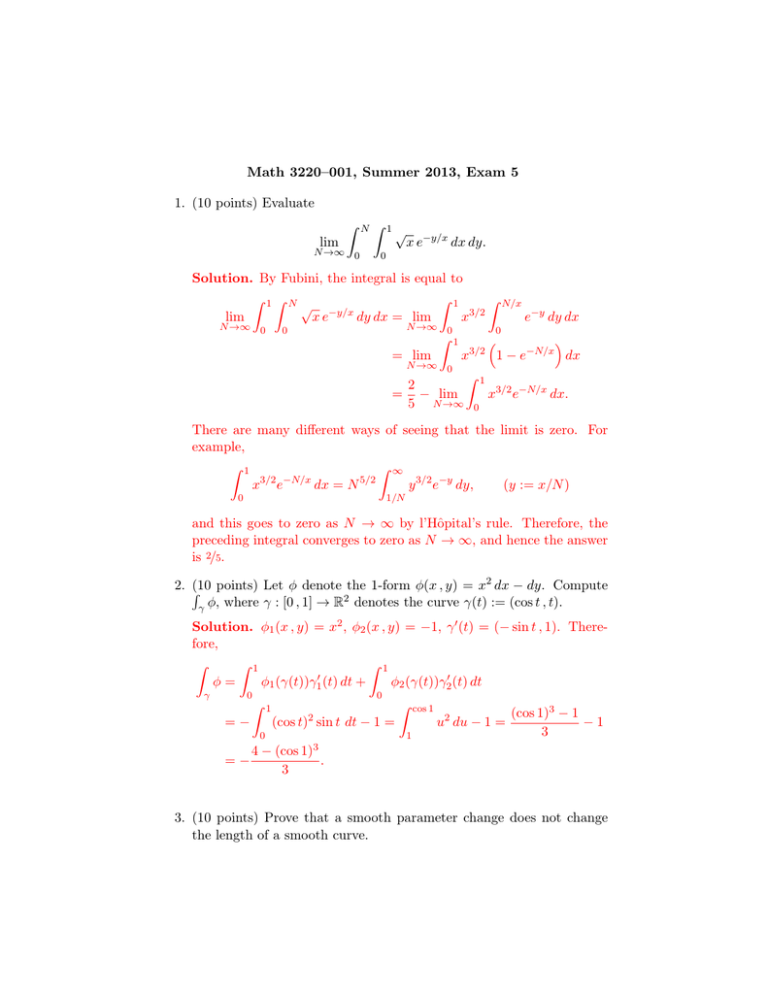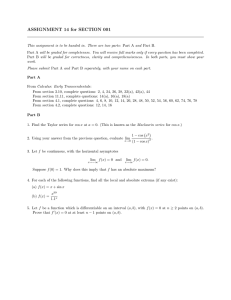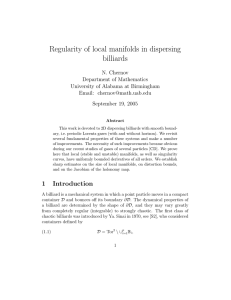Math 3220–001, Summer 2013, Exam 5 1. (10 points) Evaluate √ Z
advertisement

Math 3220–001, Summer 2013, Exam 5 1. (10 points) Evaluate Z N Z lim N →∞ 0 1√ x e−y/x dx dy. 0 Solution. By Fubini, the integral is equal to Z N/x Z 1Z N Z 1 √ −y/x 3/2 e−y dy dx x lim xe dy dx = lim N →∞ 0 N →∞ 0 0 0 Z 1 x3/2 1 − e−N/x dx = lim N →∞ 0 Z 1 2 = − lim x3/2 e−N/x dx. 5 N →∞ 0 There are many different ways of seeing that the limit is zero. For example, Z ∞ Z 1 3/2 −N/x 5/2 x e dx = N y 3/2 e−y dy, (y := x/N ) 1/N 0 and this goes to zero as N → ∞ by l’Hôpital’s rule. Therefore, the preceding integral converges to zero as N → ∞, and hence the answer is 2/5. 2. R(10 points) Let φ denote the 1-form φ(x , y) = x2 dx − dy. Compute 2 γ φ, where γ : [0 , 1] → R denotes the curve γ(t) := (cos t , t). Solution. φ1 (x , y) = x2 , φ2 (x , y) = −1, γ 0 (t) = (− sin t , 1). Therefore, Z Z 1 Z 1 φ= φ1 (γ(t))γ10 (t) dt + φ2 (γ(t))γ20 (t) dt γ 0 0 Z =− 1 (cos t)2 sin t dt − 1 = 0 Z 1 cos 1 u2 du − 1 = (cos 1)3 − 1 −1 3 4 − (cos 1)3 =− . 3 3. (10 points) Prove that a smooth parameter change does not change the length of a smooth curve. Solution. Let γ : [a , b] → Rp be a smooth curve, and α : [c , d] → [a , b] a smooth parameter change from γ to λ := γ ◦ α. We have d Z Z 0 kλ (t)k dt = `(λ) = c d γ 0 (α(t))α0 (t) dt, c thanks to chain rule. Now, α0 (t) is a scalar and has a constant sign. Therefore, kγ 0 (t)α0 (t)k = α0 (t)kγ 0 (t)k. Therefore, Z d 0 0 Z b kγ (α(t))k|α (t)| dt = `(λ) = kγ 0 (s)k ds, a c after a change of variables. The latter quantity is `(γ). 4. (10 points total) Let ϕ : R2 → R2 be the function that rotates (x , y) ∈ R2 by 45◦ ; that is, x + y √ 2 ϕ(x , y) = . x − y √ 2 Let R denote the rectangle R := [0 , 1] × [0 , 1]. (a) (5 points) Plot ϕ(R). (b) (5 points) Compute, using the change of variable formula of chapter 10, the volume of ϕ(R). √ √ Solution. ϕ(R) is the lozenge whose vertices are at (0 , 0), (1/ 2 , 1/ 2), √ √ √ (1/ 2 , −1/ 2), and ( 2 , 0). Note that ϕ is smooth, and ! 1 1 √ 2 √1 2 dϕ(x , y) = √ 2 − √12 ⇒ det dϕ(x , y) = −1. We know, from Chapter 10, that Z Z V (ϕ(R)) = | det dϕ(x , y)| dV (x , y) = dV (x , y) R = V (R) = 1. R







